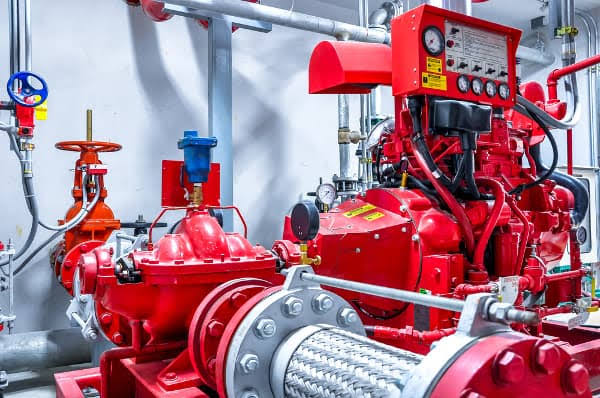Tips To Maintain Fire Fighting Water Pump In Extreme Weather Conditions

Maintaining fire fighting water pumps in extreme weather conditions is crucial for ensuring their reliability and performance when needed most. The key to maintaining these pumps lies in proper preparation and operational best practices. During winter, for instance, preventing water from freezing in the pump mechanisms is paramount. Operators should ensure that any wet clothing is replaced immediately to prevent the cooling down of the body’s core temperature, which can affect their efficiency during emergencies.
In addition to personal safety, managing the equipment is equally important. Inside fire stations, the temperature is controlled, reducing the chances of water in the pumps freezing. But once the trucks are out in the field, special measures must be taken. For example, keeping the tank-to-pump valve fully open and partially opening the tank-fill valve helps maintain adequate circulation and prevents freezing issues. Regular monitoring during these operations is essential.
Equip the team with high-quality, reliable fire fighting water pumps to ensure they can perform optimally. Such equipment can be found among various suppliers and must be chosen carefully to meet specific needs. When dealing with extreme weather conditions, preparedness, safety, and proper equipment handling are pivotal factors in effective firefighting operations.
Key Takeaways
- Proper preparation and operational practices are essential.
- Prevent water in pumps from freezing by maintaining circulation.
- Quality equipment and monitoring ensure optimal pump performance.
Preparing for Extreme Weather Conditions
Maintaining firefighting equipment, particularly water pumps, in extreme weather conditions is crucial. Understanding the impact of weather, adapting measures for both heat and cold, and protecting equipment ensures operational efficiency and safety for firefighters.
Understanding the Impact of Weather on Operations
Weather significantly affects fire operations. Extreme heat can cause dehydration and heat exhaustion in firefighters, while cold weather increases risks of hypothermia and movement difficulties due to heavy clothing. Heavy wind and snow loads can obstruct movement and visibility, and frozen hydrants can hinder water access. It is essential for the fire department to assess these risks regularly and plan strategies to mitigate their effects.
Adapting to Extreme Heat and Cold
Adapting to extreme weather involves specific measures tailored to heat and cold. During a heat wave, ensuring firefighters have access to hydration and cooling stations is vital. Equipment should be stored in shaded areas to prevent overheating.
In cold weather, pre-treating areas with antifreeze can prevent frozen hydrants. Vehicles and equipment must be checked to ensure they function correctly at low temperatures. Pumping systems should be maintained to ensure they can handle icy conditions without malfunctioning. Fire departments should also provide heated shelters for rest periods during prolonged operations.
Protecting Fire Fighting Equipment from the Elements
Protecting equipment from the elements is fundamental. Implementing measures such as regular inspections and timely maintenance helps in this regard. When expecting extreme cold, apply antifreeze on caps and plugs to prevent freezing. Keeping water pumps and other equipment within temperature-controlled environments when not in use is essential.
For extreme heat conditions, ensure that equipment left outdoors is shielded from direct sunlight using insulated covers. During operations in heavy wind, snow, or ice, securing all equipment and vehicles can prevent damage and ensure they remain operational. Fire departments should also have protocols to ensure quick access and use of equipment even when frozen or snow-covered.
Operational Best Practices in Harsh Conditions
Ensuring the proper operation of firefighting water pumps in extreme weather conditions is crucial. This involves focusing on water supply and delivery, maintaining personnel safety and performance, and optimizing communication and tactical strategies.
Maintaining Water Supply and Delivery
In extreme temperatures, whether hot or cold, maintaining a consistent water supply is paramount. Firefighters need to ensure that hydrants are accessible and operable. In cold weather, ice can obstruct hydrants, requiring frequent checks and potentially thawing equipment.
Pump operators must regularly monitor pump pressures and nozzle pressure to prevent cavitation and ensure effective water delivery. When working at high-rise fires, the use of tandem pumping might be necessary to achieve the required pressure levels.
For large-scale operations, using master streams such as deck guns can improve suppression efforts. Operators should also be mindful of dump valves and dump tanks in rural areas where hydrants may not be available.
Ensuring Personnel Safety and Performance
Firefighters face significant physical and environmental challenges during operations in harsh conditions. Proper hydration is essential to prevent dehydration and heat-related illnesses in extreme heat. Supervisors should monitor personnel for signs and symptoms of heat exhaustion and provide breaks to reduce fatigue.
During extreme cold, ensuring firefighters are dressed appropriately to avoid frostbite is critical. Adequate ventilation in smoke-filled environments helps maintain visibility and air quality, impacting overall well-being.
Regular checks on firefighters’ physical condition help in identifying early warning signs of stress or injury. Adequate salt intake and electrolyte replenishment can mitigate the effects of intense sweating and prevent cramps.
Communication and Tactical Considerations
Effective communication is essential for coordinating firefighting efforts and ensuring safety in extreme weather. Radio communications should be clear and consistent, with frequent updates from supervisors to keep track of team positions and status.
Tactical considerations should include adapting to limited visibility and extreme temperatures. For instance, in high-temperature scenarios, reducing physical exertion and extending rest periods can mitigate the impact of heat.
Firefighters need to develop tactical strategies to address specific challenges posed by extreme conditions. This might include pre-placing pumpers and aerials for optimal coverage or adjusting hose lay patterns to ensure quick access and maneuverability.
Ensuring that all personnel are equipped to communicate seamlessly and understand their roles can significantly enhance the effectiveness of firefighting operations in harsh environments.
Conclusion
Maintaining firefighting water pumps in extreme weather conditions is essential for operational readiness and efficiency. Regular inspections, proper training, and adequate equipment are crucial steps. Adhering to these best practices ensures that fire departments can effectively respond to emergencies, regardless of the weather. By implementing these strategies, fire personnel can mitigate risks and enhance safety and performance.



